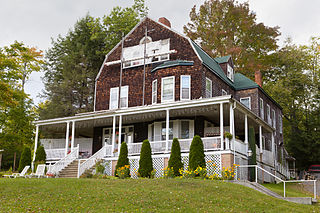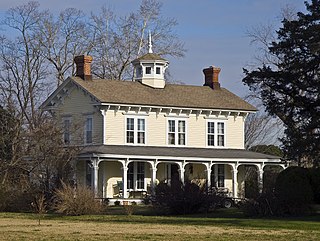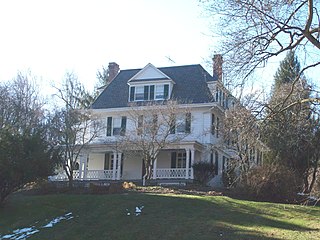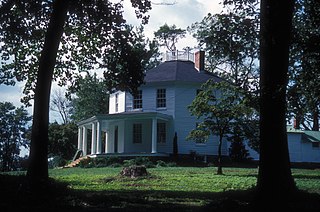
The Elmer McCollum House is a historic house at 2301 Monticello Road in Baltimore, Maryland. Built about 1920, it is significant for its association with Johns Hopkins University researcher Elmer McCollum (1879-1967), who lived in the house from 1929 to 1939. During this period, McCollum conducted significant research into nutritional disease. The house was designated a National Historic Landmark in 1973.
Big Bottom Farm is a farm in Allegany County, Maryland, USA on the National Register of Historic Places. The Greek Revival house was built circa 1845, possibly by John Jacob Smouse, and exhibits a level of historically accurate detailing unusual for the area. The property includes a late 19th-century barn and several frame outbuildings.

The George Washington House, or Indian Queen Tavern, is located at Baltimore Avenue, at Upshur Street, in Bladensburg, Prince George's County, Maryland. It was constructed in the 1760s. The 2+1⁄2-story structure is constructed of brick Flemish bond on ends. The plan is rectangular, with a gabled roof, exterior end chimneys, gabled shingled dormers. There are first and second-story center entrances, each with a transom. There is a full-width one-story porch with balustraded deck and side entrances. The structure includes a later two-story rear addition. The structure is Georgian.

The Curtis—Shipley Farmstead is a historic home located at Ellicott City, Howard County, Maryland, United States. It is located on the first land grant in modern Howard County, then Anne Arundel County, to the English settler Adam Shipley in 1688 who settled properties in Maryland as early as 1675. The 500-acre estate was called "Adam the First".
The Joseph D. Lyons House is a historic home in Sunderland, Calvert County, Maryland, United States that is listed on the National Register of Historic Places. It is privately owned and not open to the public.

Turkey Hill is a historic home at Linthicum Heights, Anne Arundel County, Maryland, United States. It was built about 1822 by William Linthicum. Originally the house consisted of a 1+1⁄2-story frame section and a three-story field stone section linked together by an open porch. As the family increased in size, Linthicum added another story to the frame portion, making it two and a half stories high. Also on the property is a birdhouse, modeled after Camden Station in Baltimore City; a late-19th-century carriage house; a late-19th-century meathouse; and an early-20th-century garage also stand on the property.

Portland Manor is a historic home at Lothian, Anne Arundel County, Maryland, United States. It is a 2-story, center-passage plan, frame building. The main block was constructed in 1754, with the two wings added and enlarged about 1852. Also on the property are the remains of a large circular ice house and several frame outbuildings. Portland Manor was listed on the National Register of Historic Places in 1996.

Thainston is a farm complex and national historic district in La Plata, Charles County, Maryland, United States. The main house is a two-story, L-shaped brick house built in 1865 and enlarged early in the 20th century. It was designed by Eben Faxon, a Baltimore architect, and constructed under the supervision of Charles Ogle, a building contractor also from Baltimore. The farm developed between 1865 and the 1930s. Included on the property are a number of early dependencies, including a wellhouse, a brick dairy, a storage building, and a meathouse. A frame garage and large chicken house, both dating from the early 1900s, are on the property. There is also a collection of agricultural buildings including: tobacco barns, cattle barns, and equipment sheds clustered around a corncrib/granary. There are three frame tenant houses, several associated sheds, a probably early building site, an early well, a pit remaining from a former ice house, and the former ice ponds. Another early-20th century building, a tobacco barn, stands in a field to the west of the main grouping of agricultural buildings.

The Inns on the National Road is a national historic district near Cumberland, Allegany County, Maryland. It originally consisted of 11 Maryland inns on the National Road and located in Allegany and Garrett counties. Those that remain stand as the physical remains of the almost-legendary hospitality offered on this well-traveled route to the west.

The Pennington Cottage is a historic home located at Deer Park, Garrett County, Maryland, United States. It is a 2+1⁄2-story, late-19th-century Shingle-Style frame structure, with a gambrel roof and a one-story porch that stretches across the principal facade and along portions of the sides. The house is entirely covered with dark wood shingles. It was built as a part of the Baltimore and Ohio Railroad's Deer Park Hotel complex, as the summer home of Baltimore architect Josias Pennington.

Memory Lane is a historic home located at Denton, Caroline County, Maryland. It a 2+1⁄2-story, frame Italianate-style house constructed in 1864. Notable exterior features include extensive porches, decorative brackets, and an octagonal cupola. The entire front facade features a wraparound porch.
Llandaff House is a historic home in Easton, Talbot County, Maryland, United States. It is a 2+1⁄2-story irregular plan frame house built in 1877–78, in a combined Queen Anne and Eastlake style. It features an asymmetrical front facade with a central entrance incorporated in a projecting two-story, two-bay pavilion distinguished by an open porch on the first floor. Also on the property are a late-19th-century three-story combination water tower and windmill and an early-20th-century frame boathouse. The grounds were professionally designed and executed by New York landscape architect Thomas Hogan.

Choate House is a historic home located at Randallstown, Baltimore County, Maryland. It is a 2+1⁄2-story gable-roofed stone building built in 1810, with a porch and dormers added in the 1880s. The Italianate style was probably applied in the 1880s and include a full-length porch.

The Wilderness is a historic home located near Catonsville, Baltimore County, Maryland. It is a large stone and frame house located in a wooded setting west of Catonsville. The original home was built about 1800, and it attained its current appearance following a major expansion in 1899–1900, when it was a summer residence of Francis Cumberland Dugan II (1830-1914). It features multiple roof and dormer shapes and a wraparound porch reminiscent of the Queen Anne style. The third story is located within a tall mansard roof. Also on the property are a stone springhouse / smokehouse, a summer kitchen, log tenant house, and a large frame barn.

The Nelson-Reardon-Kennard House, also known as the Methodist Parsonage, is a historic home located at Abingdon, Harford County, Maryland, United States. It is a two-part frame house, with a five-bay, two-story front section built about 1785 and a three-bay, one-room rear service wing. The front porch dates to 1888. It is the oldest documented frame dwelling in Harford County.

Wildfell is a historic home located at Darlington, Harford County, Maryland, United States. It is a two-story, octagonal house of stacked plank construction, featuring an 8-sided roof topped by an octagonal "captains walk," flanked by two brick chimneys. The house has a simplified Federal style. It was built about 1854, and served as summer home for the Jewett family until 1874.

Gladden Farm, also known as Gladden-Roming Stone House, is a historic home and farm complex located in Street, Maryland. The complex includes three historically-significant structures: a large five-bay rubblestone bank house with Federal detailing, a one-story rubblestone spring house, and a one-story board-and-batten frame shop.

Carroll County Almshouse and Farm, also known as the Carroll County Farm Museum, is a historic farm complex located at Westminster, Carroll County, Maryland. It consists of a complex of 15 buildings including the main house and dependencies. The 30-room brick main house was originally designed and constructed for use as the county almshouse. It is a long, three-story, rectangular structure, nine bays wide at the first- and second-floor levels of both front and rear façades. It features a simple frame cupola sheltering a farm bell. A separate two-story brick building with 14 rooms houses the original summer kitchen, wash room, and baking room, and may have once housed farm and domestic help. Also on the property is a brick, one-story dairy with a pyramidal roof dominated by a pointed finial of exaggerated height with Victorian Gothic "icing" decorating the eaves; a large frame and dressed stone bank barn; and a blacksmith's shop, spring house, smokehouse, ice house, and numerous other sheds and dependencies all used as a part of the working farm museum activities. The original Carroll County Almshouse was founded in 1852 and the Farm Museum was established in 1965.

Glyndon Historic District is a national historic district in Glyndon, Baltimore County, Maryland, United States. It is a turn-of-the-20th-century community northeast of Reisterstown, Maryland, that began as a summer resort. The district is residential except for a small business district located at the intersection of Butler Road and the Western Maryland Railway tracks. The Emory Grove Campground on the northern boundary is occupied in the summer. A decided architectural homogeneity exists in Glyndon representing vernacular examples of late 19th century styles. They are typically frame, 2+1⁄2-story-high cottages, with one or occasionally 2-story front porches.
The Henry Smeltzer Farmstead is a historic home and farm complex located near Middletown, Frederick County, Maryland, United States. It includes a two-story six-bay brick farmhouse dating to about 1832, a frame bank barn ruin, and several rusticated concrete block silos. A concrete block slaughter house, weighing house well house and holding pens complete the complex, which was associated in the early and mid-twentieth century with Main's Meats in Middletown. The house is built into the hillside as a "bank house", with its cellar above grade on the south side. The front and rear elevations feature porches across their widths.






















